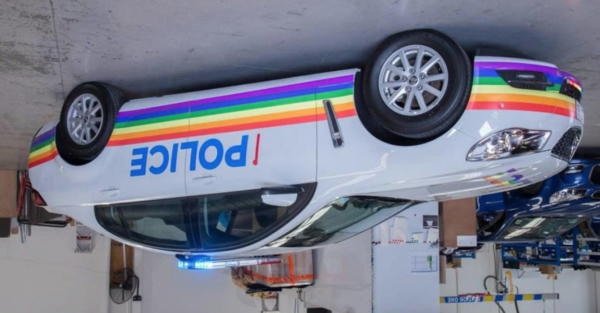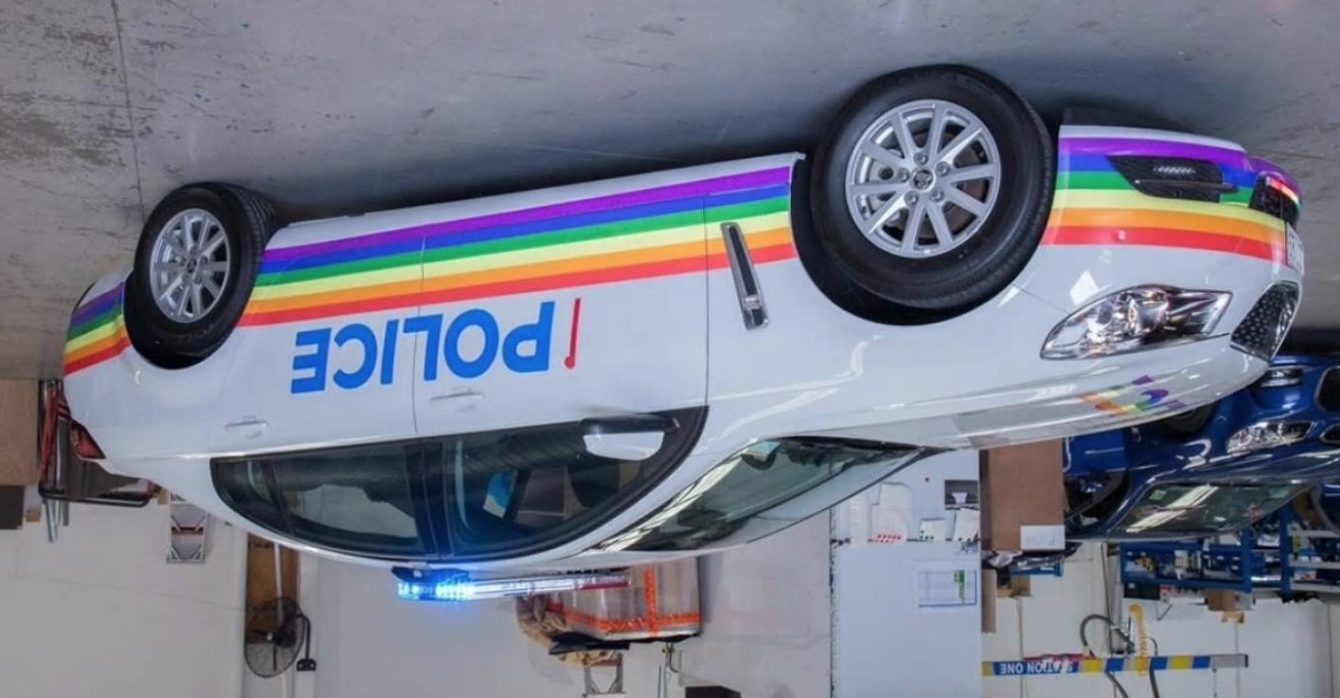
A grim investigation over the Identity Politics schism that has mutilated the Pride Parade…
Auckland’s Pride festival: What went wrong?
THE ELECTION of a new Pride board in 2018 meant a fresh strategy. The new chairperson, Cissy Rock, was an organisational developer with a 20-year history of working on strategic solutions for community and government groups.
Board members, a mix of old and new, included Michael Lett, the gallerist and now board secretary, Ta’i Paitai, an event organiser, Zakk d’Larte, a graphic designer, and Phylesha Brown-Acton, who negotiates services for Pacifica transgendered people. Two others, including the board treasurer, would shortly choose to resign.
Over a month, there were four community hui, including one online, held by Auckland Pride, to consult about the shape of the events.
“People really did want Pride to be more queer, more political, less corporate, and more balanced – with a grass-roots community feel,” says Rock.
“And there was also a question about State institutions – not just the Police, but Corrections – their participation and what it meant.”
While issues of race and age were the most prominent subjects in the subsequent summary produced by the board, the only “hot topic hui” that followed was focused on police.
“That seemed to be the one that needed a more 360 degree look at it,” said Rock. “I facilitated that hui … I was upfront … We are here to hear each other, we are not representing organisations, we are here to really get a sense of what the broader community is thinking and feeling around this … There was some raw stuff said.”
Subsequently, in early November 2018, the board announced that while they “welcomed” GLBTQI+ police officers marching in the parade in 2019, they would not be welcome to march in uniform as they had done since 2015.
It was suggested they could march in T-shirts.
Pride stated that while there was “goodwill” towards the police, the organisation did not “currently meet the degree of safety and awareness of intersectionality required by our Rainbow Communities”.
To judge by online discussion and questions, “intersectionality” was not a familiar concept to most of the board’s constituency. It is defined as a framework that examines how systems of power impact upon society’s most marginalised people.
No compromise could be negotiated. GLBTQI+ police withdrew from the event – while allowing for a future engagement. Almost immediately, the New Zealand Defence Force said it would follow suit. Private companies began reassessing their involvement.
“I was surprised by the police’s reaction because it was very cut and dry,” said Rock. “It was either they march in uniform or it was nothing.”Two Pride board members, Matty Jackson and Verity George, resigned following the decision. “I can’t honestly support the decisions that were made,” Jackson tweeted. “My values and that of Auckland Pride are no longer aligned and this is not a decision I have made lightly.”
Tension and emotion ran high.
“I think that the board had totally underestimated how much community interest there was,” said Michael Stevens as he described the Grey Lynn public meeting that followed on Sunday, November 12. “I’d guess there were around 250 to 300 people there by the end. The atmosphere was tense and rancorous.”
The board’s chosen independent facilitator, Tim Foote, who had flown in from Wellington for the job, seemed unaware of the strength of emotion in Auckland. He started the meeting with a poem but the audience was restive. A number of PAPA members were present, including Rākete, and they had placed themselves centre-stage.
Rākete described herself to the meeting as “a Marxist-Leninist criminologist”. She would go on to hold up a photograph and read out the names of each of the 15people killed In New Zealand as a result of an interaction with police in the previous 10 years, no matter the circumstances.
“Our goal is to call attention to the crisis and contradictions inherent in the New Zealand justice system,” Rākete said. “We want to call attention to the ways it doesn’t solve social problems, how the criminal justice system has worsened inequality and how it is fundamentally pointless and dysfunctional and needs to be replaced with community justice, something which can work and help people.”
Many of PAPA’s statements were focused on the subject of race, rather than GLBTQI+ people. It was a blurring of issues that would confuse many.
Rākete cited the annual Police Tactical Options Research Report, which examines all incidents in which police have used pepper-spray, closed fist-blows, tasering, use of attack dogs or shooting.
“In 2014, the first year that police officers marched in the parade, Māori were 7.1 times more likely to be victims of one of these forms of police violence,” Rākete said. “The most recent Tactical Options Report has data from 2017 that shows Māori were nearly 7.7 times more likely than Pākehā to be made victims of one of these forms of police violence.”
“That trend has continued every year that the police have marched in the Pride Parade.”
PAPA’s view was that police have no place in the parade “until those statistics don’t reflect a massive disproportionate racist use of violence by police”. PAPA, however, offered to support the proposal that the police continue to march in the parade – but not in uniform.The Grey Lynn meeting erupted. Individual and group walk-outs began. A scuffle ensued. Emotions ran high.
“It was a mess. A painful, angry mess, and showed just how deeply divided the GLBTQI+ communities are,” Stevens says. “The board has been inept in how it dealt with the entire process from the start.”
“Suddenly deciding to reverse the right of the police to march in uniform as they had for the previous three years, with no meaningful consultation, showed a complete lack of foresight as to the consequences.”
…Rainbow Police fought for the right to march in Uniform, that the Board didn’t seem to understand they would refuse point blank to accept stripping them of that right is either naive or disingenuous. Even other trans activists who work for the community believe this decision was a terrible mistake…
STACEY KERAPA, a Māori trans woman and a former K Rd sex-worker is now a graduate student doing an MA, after specialising in psychology, social work and community development.
She is adamantly supportive of uniformed police marching in the parade, despite vividly remembering the past.
The early 1990s were “a quite horrific time for the trans community”, she says. “The Homosexual Law Reform Act didn’t include trans people in any way, shape or form. We became very easy targets for police, mainly the younger police officers, those who had just graduated from the Police College and had just become constables.”
She describes what she calls “hunting exercises”, where officers needing to make an arrest quota would go up to K Rd and “find a tranny”. Resisting arrest, refusal to obey a police order, the Misuse of Drugs Act and any number of other charges could often be arbitrarily applied.
“We would fight back and they would get us into the back of the car and down to the police station and they would use what we would call ‘the old phonebook tactic’. Rather than physically harm you and leave a mark or anything like that, they would stick the phonebook up your dress and hit it with a baton, so you would feel the full impact of the hit but it wouldn’t leave any bruises or marks.”
Since then, Kerapa says, there has been a “360 degree turn-around”.
“The police are actually really quite approachable now. They don’t use the ‘hunting tactic’ anymore. The only time you ever get harassed by a police officer is when you are obviously breaking the law.”
When a member of the GLBTQI+ communities works openly in the police, Kerapa says, “they have to have a high level and standard of belief in themselves and their work. The removal of their ability to wear their uniform in Pride is a totally demoralising thing.”
Kerapa believes that the board’s decision has destroyed “nearly 35 years of progress with Police and Corrections”.“I think what it has done to the community has shoved a wedge between all of us. We come from a community that has survived huge fragmentation. It has taken us decades to bridge those gaps. In the space of less than three months an arbitrary decision made by the board as a result of an incomplete consultation process has totally demoralised and destroyed that unity.”
There is legitimate grievance in the class divide within the rainbow community, but it hasn’t been argued on those merits, it’s been argued on identity and that is deeply corrosive to solidarity
When woke empowerment means exclusion, you are losing the wider battle. This Pride Parade meltdown example matters because as progressive movements are flooded with Millennials demanding trigger free safe spaces and identity politics uber allas, the ramifications for the wider political Left are sobering.
We are alienating voters with social justice fights thousands of miles away from the lived experience of poverty and exploitation by neoliberal capitalism.
So instead of a parade, we will have a woke walk. The only people turning up to this will be a bus load of Action Station groupies, the Green Party caucus and gender fluid activists numbering in their hundreds.
I’m not exactly sure how this counts as a progressive victory. Pure Temple politics vs Broad Church politics might win quick battles, but ultimately loses wars. The woke beat down the wider community concerns and have ended up with something that has set the entire rainbow community backwards while robbing Auckland of an important celebration in diversity.
Remember, this was all started because trans people might be triggered by a Police uniform, Everyone feeling triggered yet?
The most painful bit about the Pride Parade meltdown is that as far as the millennial protagonists who started this are concerned, it’s not in any way shape or form a blunder by the over zealous woke Board but instead a massive patriarchal capitalist conspiracy to fascistly re-instate gender binary norms.
Sigh. Kill me now.






“Oppression Olympics”. Are we at peak nonsense yet? Please tell me we’re at peak nonsense.
https://en.wikipedia.org/wiki/Oppression_Olympics
Yawn, when do we get pink police vehicles?
The problem with your piece is that women like Stacey Kerapa who was beaten and hassled by police in the eighties are now in the age group of “people in power” so is less likely to be attacked. The bullies who use the power of their positions will not bully people who are likely to resist or assert. So for her to say “The police are actually really quite approachable now. They don’t use the ‘hunting tactic’ anymore” is true for her, but not for all LGBT+ members as seen by the large division between age groups. They should march when there is an acknowledgement of the way our police treat people. No matter what the things done to Stacey were illegal, no one has ever been demoted, prosecuted or even apologized. The police now say oops we are better at treating the community now – we have a rainbow coloured car!
Comments are closed.